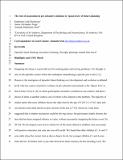Files in this item
The role of association in pre-schoolers' solutions to "spoon tests" of future planning
Item metadata
| dc.contributor.author | Dickerson, Katherine L. | |
| dc.contributor.author | Ainge, James A. | |
| dc.contributor.author | Seed, Amanda M. | |
| dc.date.accessioned | 2019-07-04T23:40:32Z | |
| dc.date.available | 2019-07-04T23:40:32Z | |
| dc.date.issued | 2018-07-23 | |
| dc.identifier | 253109214 | |
| dc.identifier | ef1b2b7c-5328-4a4e-83ca-4c3727a2e6b8 | |
| dc.identifier | 85049327049 | |
| dc.identifier | 000439472600028 | |
| dc.identifier.citation | Dickerson , K L , Ainge , J A & Seed , A M 2018 , ' The role of association in pre-schoolers' solutions to "spoon tests" of future planning ' , Current Biology , vol. 28 , no. 14 , e2 , pp. 2309-2313 . https://doi.org/10.1016/j.cub.2018.05.052 | en |
| dc.identifier.issn | 0960-9822 | |
| dc.identifier.other | ORCID: /0000-0002-3867-3003/work/60426854 | |
| dc.identifier.other | ORCID: /0000-0002-0007-1533/work/60428111 | |
| dc.identifier.uri | https://hdl.handle.net/10023/18044 | |
| dc.description | KLD was funded by a Bobby Jones scholarship and by the University of St Andrews. | en |
| dc.description.abstract | Imagining the future is a powerful tool for making plans and solving problems. It is thought to rely on the episodic system which also underpins remembering a specific past event [1, 2, 3]. However, the emergence of episodic future thinking over development and evolution is debated [4, 5, 6, 7, 8, 9]. One key source of positive evidence in pre-schoolers and animals is the “spoon test” or item choice test [4, 10], in which participants encounter a problem in one context and then a choice of items in another context, one of which is the solution to the problem. A majority of studies report that most children choose the right item by age 4 [10, 11, 12, 13, 14, 15, cf. 16]. Apes and corvids have also been shown to pass versions of the test [17, 18, 19]. However, it has been suggested that a simpler mechanism could be driving choice: the participant simply chooses the item that has been assigned salience or value, without necessarily imagining the future event [16, 20, 21, 22, 23]. We developed a new test in which two of the items offered to children were associated with positive outcomes, but only one was still useful. We found that older children (5-, 6-, and 7-year-olds) chose the correct item at above chance levels, but younger children (3- and 4-year-olds) did not. In further tests, 4-year-olds showed an intact memory for the encoding event. We conclude that positive association substantially impacts performance on item choice tests in 4-year-olds and that future planning may have a more protracted developmental trajectory than episodic memory. | |
| dc.format.extent | 688277 | |
| dc.language.iso | eng | |
| dc.relation.ispartof | Current Biology | en |
| dc.subject | Episodic future thinking | en |
| dc.subject | Associative learning | en |
| dc.subject | Foresight | en |
| dc.subject | Planning | en |
| dc.subject | Mental time travel | en |
| dc.subject | BF Psychology | en |
| dc.subject | DAS | en |
| dc.subject | BDC | en |
| dc.subject.lcc | BF | en |
| dc.title | The role of association in pre-schoolers' solutions to "spoon tests" of future planning | en |
| dc.type | Journal article | en |
| dc.contributor.institution | University of St Andrews. Institute of Behavioural and Neural Sciences | en |
| dc.contributor.institution | University of St Andrews. School of Psychology and Neuroscience | en |
| dc.contributor.institution | University of St Andrews. ‘Living Links to Human Evolution’ Research Centre | en |
| dc.contributor.institution | University of St Andrews. Centre for Social Learning & Cognitive Evolution | en |
| dc.identifier.doi | 10.1016/j.cub.2018.05.052 | |
| dc.description.status | Peer reviewed | en |
| dc.date.embargoedUntil | 2019-07-05 |
This item appears in the following Collection(s)
Items in the St Andrews Research Repository are protected by copyright, with all rights reserved, unless otherwise indicated.

